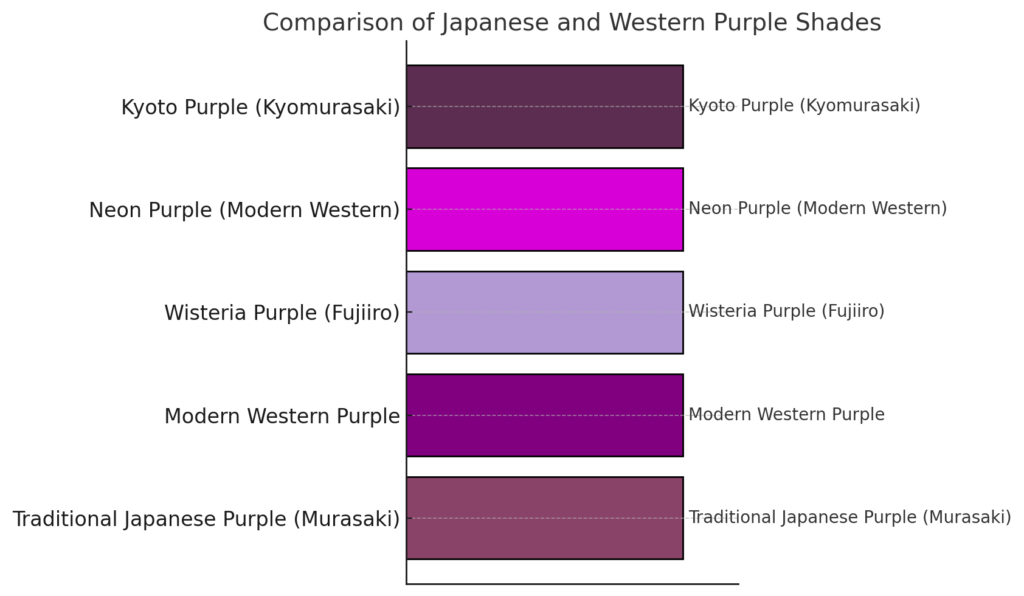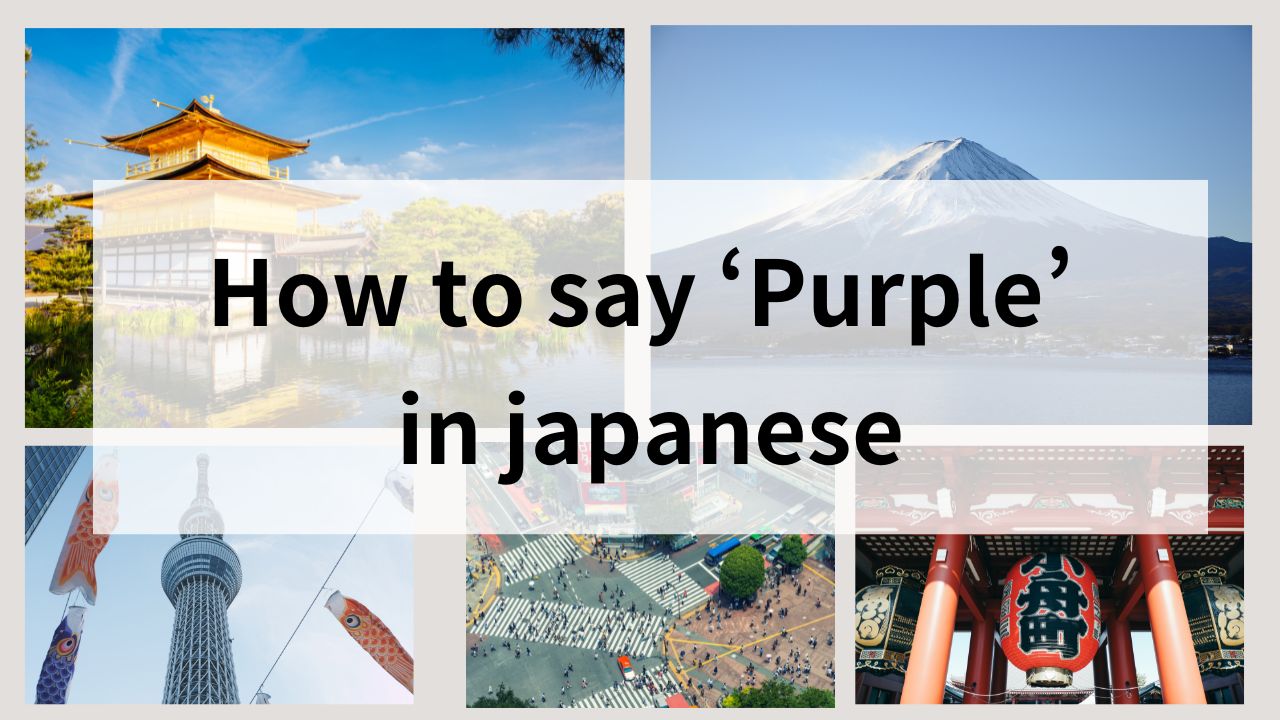Are you curious about how to say “purple” in Japanese? The color purple holds various cultural meanings and associations in Japan, from aesthetics to symbolism. This guide will explore the Japanese word for “purple,” its cultural significance, and practical applications.
How Do You Say “Purple” in Japanese?
The Japanese word for “purple” is 紫 (murasaki). This term is widely recognized and used in both casual and formal contexts. The color purple has a rich history in Japan, often associated with nobility and spirituality.
The Japanese Word for Purple: Murasaki (紫)
“Murasaki” is a term used to describe the color purple and appears in various phrases and contexts. For example:
- 紫の花 (Murasaki no hana): “Purple flower.”
- 紫の服 (Murasaki no fuku): “Purple clothes.”
- 紫色の空 (Murasakiiro no sora): “Purple sky.”
Kanji for Purple: 紫
The kanji for purple, 紫, is often used in literature, traditional contexts, and everyday language. This visually striking character reflects the beauty and depth of the color. The primary reading for this kanji is むらさき (Murasaki), but it also has an alternative reading, し (Shi), which appears in compound words.
Examples of words containing the kanji 紫 include:
- 紫陽花 (Ajisai): “Hydrangea,” a flower often associated with shades of purple.
- 紫色 (Murasaki iro): “Purple color,” used to describe the general shade.
- 紫外線 (Shigaisen): “Ultraviolet rays,” where the color purple symbolizes the spectrum beyond visible light.
This kanji is commonly associated with things that are purple or have a connection to the color’s symbolism of elegance and nobility. Recognizing these patterns can help learners understand the nuanced use of 紫 in Japanese.
Does “Purple” Work in Japanese?
The English word “purple” is generally understood in Japan, especially among younger generations or those familiar with fashion and modern culture. However, its recognition might be less universal among older individuals or in more traditional contexts. A 5-point scale rates its comprehension as:
- Rating: 4 – Generally understood (60-80% of people)
Rating Details
Understanding the 5-Point Rating for English Words in Japan
The following ratings help explain how English words are typically understood in Japan. The scale is based on context, familiarity, and the target audience.
- 5 - Universally understood (80% or more):
Words that are widely adopted into everyday Japanese, such as "coffee" (コーヒー) or "computer" (コンピューター). These words are part of the standard vocabulary and are recognized by nearly everyone. - 4 - Generally understood (60-80%):
Words that are familiar to most people but might require context for full comprehension. Examples include terms commonly used in specific industries or by younger generations. - 3 - Understood in half of the cases (40-60%):
Words that depend heavily on pronunciation or context. For example, technical terms or less common foreign words that some people may not immediately recognize. - 2 - May not be understood (20-40%):
Words that are unfamiliar to most Japanese speakers unless they have significant exposure to English or specific cultural contexts. These words are often better replaced with their Japanese equivalents. - 1 - Rarely understood (20% or less):
Highly specialized or obscure terms that are unlikely to be recognized by the general public. Clear communication requires the use of Japanese vocabulary or additional explanation.
This rating system provides a practical guide for determining when and how to use English words effectively in Japan. Understanding the audience and context is key to ensuring clear communication.
If clarity is crucial, using the Japanese term むらさき (Murasaki) or 紫色 (Murasaki iro) is recommended. While “purple” may be understood in certain contexts, “murasaki” ensures effective communication.
The Cultural Significance of Purple in Japan
Purple has held a special place in Japanese culture for centuries, symbolizing nobility, power, and spirituality. It was historically reserved for the elite classes and used in royal garments.
Purple as a Symbol of Nobility
In ancient Japan, purple dye was rare and expensive, making it a color associated with the aristocracy. Even today, purple retains its regal connotations, often seen in royal ceremonies and traditional clothing.
Purple in Japanese Folklore and Mythology
Purple appears in various Japanese myths and stories, often symbolizing mystery and the supernatural. It is sometimes linked to deities and spirits, enhancing its mystical qualities.
In addition to its traditional associations, purple plays a significant role in modern Japanese pop culture, particularly in anime and games. This connection further emphasizes the color’s enduring mystique and depth.
- Bleach: The character Byakuya Kuchiki uses a technique called “Senbonzakura Kageyoshi,” where purple cherry blossoms form a mystical and deadly attack, highlighting both elegance and power.
- Naruto: The character Sasuke Uchiha often emits a purplish aura when using his Susanoo, symbolizing immense power and mystery.
- Fate/stay night: Servant characters like Rider (Medusa) are often associated with purple tones, reflecting their connection to the supernatural and divine myths.
- Pokemon: Ghost-type Pokémon, such as Gengar, are frequently depicted with purple tones to symbolize their ethereal and mischievous nature.
- Final Fantasy: The series often associates purple with magic and power, such as the iconic Black Mage costumes featuring purple accents.
These examples demonstrate how purple continues to represent mystery, power, and the supernatural, bridging traditional folklore and modern storytelling.
Differences Between Purple in Japan and Overseas
Yes, there can be subtle differences in how “purple” is perceived in Japan versus Western cultures. In Japan, “murasaki” (紫) often refers to a more subdued, elegant shade of purple, traditionally associated with royalty and spirituality. Meanwhile, in Western contexts, “purple” may include a broader range of vibrant and bold shades, often used in modern design and fashion. Understanding these cultural nuances can help avoid confusion, especially when discussing colors in creative or professional settings.

Practical Applications of “Purple” in Japanese
Learning how “purple” is used in Japanese can help you navigate conversations, understand idioms, and recognize its presence in Japanese culture.
Talking About Purple in Daily Conversation
Here are some examples of how “murasaki” is used in everyday conversation:
- 紫が好きです (Murasaki ga suki desu): “I like purple.”
- 紫色の髪 (Murasakiiro no kami): “Purple hair.”
Purple-Related Idioms or Expressions
While there are relatively few specific idioms involving “murasaki,” the color is often associated with nobility, beauty, and elegance in Japanese culture. Here are some idioms, phrases, and expressions that incorporate or symbolize purple:
- 紫の上 (Murasaki no Ue): A reference to the character Murasaki from “The Tale of Genji,” symbolizing beauty, sophistication, and idealized femininity.
- 紫紺の旗 (Shikon no Hata): Literally “a flag of deep purple,” this phrase symbolizes honor and prestige, often used metaphorically to describe noble causes or endeavors.
- 紫陽花 (Ajisai): “Hydrangea,” a flower known for its delicate purple hues. It is frequently mentioned in poetry and haiku as a symbol of transient beauty.
- 紫式部 (Murasaki Shikibu): While not an idiom, this historical figure’s name (the author of “The Tale of Genji”) is synonymous with Japanese literary elegance and refinement.
- 紫雲 (Shi’un): Literally “purple clouds,” this term is often used in Buddhist texts and traditional Japanese literature to represent divine presence or auspicious omens.
These idioms and expressions reflect the deep cultural and aesthetic appreciation of purple in Japan, often tied to themes of beauty, nobility, and spirituality. By learning these phrases, you can gain a deeper understanding of how purple is interwoven with Japanese language and values.
Purple in Japanese Cuisine or Products
Purple is also prominently featured in Japanese cuisine and products, showcasing its aesthetic appeal and health benefits. Here are some notable examples:
- Eggplant (なす, Nasu): A popular vegetable in Japanese cuisine, often grilled, simmered, or pickled, appreciated for its deep purple hue and versatile flavor.
- Purple Sweet Potatoes (紫芋, Murasaki Imo): Known for their vibrant color and natural sweetness, they are used in desserts, snacks, and traditional dishes.
- Shiso (紫蘇): A type of perilla leaf, with purple varieties often used as a garnish, pickling agent, or flavor enhancer in traditional dishes.
These examples highlight how purple is not only visually appealing but also culturally significant in Japanese cuisine, adding richness and depth to both traditional and modern dishes.
FAQs
Here are some frequently asked questions about purple in Japanese culture and language.
Is Purple a Popular Color in Japan?
Yes, purple is a popular color in Japan, often associated with beauty and elegance. It is frequently used in fashion, design, and art.
How Do You Write “Purple” in Japanese?
The word “purple” can be written in three different scripts in Japanese: hiragana, katakana, and kanji. Each script serves different purposes depending on the context and formality. Here’s a breakdown:
- Hiragana (むらさき, Murasaki):
Hiragana is the most commonly used script for “purple” in casual writing or when teaching children. It is simple and easy to read, making it ideal for everyday use. - Katakana (ムラサキ, Murasaki):
Katakana is rarely used for “purple,” but it may appear in stylistic contexts, such as advertisements, product names, or when emphasizing the word in text. - Kanji (紫, Murasaki):
Kanji is the most formal and traditional way to write “purple.” It is often used in literature, official documents, and cultural contexts. The kanji itself conveys a sense of elegance and sophistication.
Choosing which script to use depends on the tone, audience, and purpose of your communication. Understanding these variations can enhance both your written and spoken Japanese skills.
Conclusion
Purple, or “murasaki” in Japanese, is more than just a color—it symbolizes nobility, beauty, and cultural significance. By understanding its role in Japanese language and traditions, you can deepen your appreciation for this vibrant color and its place in Japanese society.








